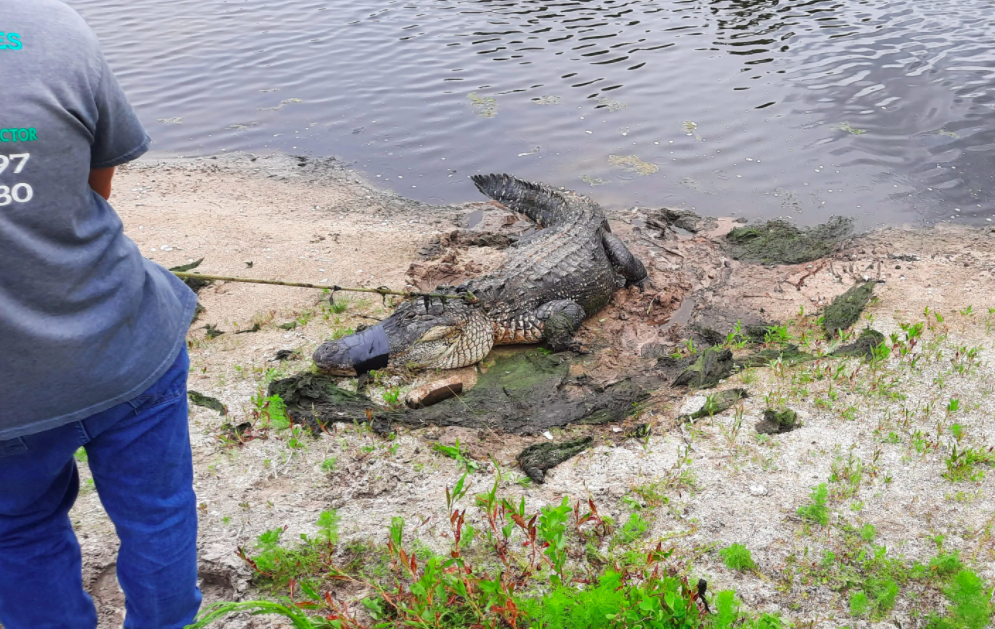SARASOTA COUNTY, Fla. – Trappers removed an injured alligator, believed to be a 10-foot-8, 300-pound male, from a pond near the 15th tee box at the Pelican Pointe Golf & Country Club near Venice late Monday morning.
“He walked across the 15th tee box, laid in the reeds for a while, and someone called the Sheriff’s Office,” said Bob Gada — pronounced like gator — who added that the gator likely wanted to slide into the nearby pond.
Gada, who did get some gentle ribbing from neighbors who asked if that was his gator, captured images of the gator and a video of it being removed.
This injured, 10-foot-8 alligator was removed from a pond by the 15th tee box at the Pelican Pointe Golf & Country Club near Venice, late Monday morning. The gator was reportedly relocated to Jurassic Ranch near Punta Gorda.
The gator has lived on or near the course for at least a year.
“He was here last year, he comes and goes,” Gada said. But this time, people noticed that the gator was dragging its right hind foot. The gator was not considered a nuisance but observers were concerned about its health.
Between that wound and the bite marks in its tail, Gada was told it may have been in a recent fight – it’s currently alligator mating season.
“If he’s 10-foot-8 and he was in a fight with somebody, I don’t want to see the somebody,” Gada added.
FWC spokesman Adam Brown said via email that the gator captured at Pelican Pointe was transferred alive to Jurassic Ranch near Punta Gorda.
Small animals do frequent the pond, as do anglers, seeking to catch some of the resident bass and tilapia.
Gada said there is another smaller gator, believed to be a Caiman, that frequents the area, too.
Alligator mating season typically runs from April through June.
Given the season, gator sightings have been increasing, including an estimated 10-foot-long gator spotted stomping around Harrington Lake in the Plantation Golf & Country Club on Easter Sunday.
While Pelican Pointe is north of Center Road, Plantation is south of it.
Also, at Lake Jervey, on the Venice campus of State College of Florida, a dog was attacked by an alligator in March.
Two gators, one a 6-foot-9 and the other 7-foot-10, were removed from lake. It was not known whether either gator attacked the dog.
Brown said that alligators are more visible in the spring, “when temperatures rise because their metabolism increases and they will begin to seek prey items such as fish, snakes, turtles, birds and small mammals.”
The FWC encourages people to keep a safe distance from alligators and never feed one, since that gator may start to associate people with food.
Swim only in designated areas during daylight, since alligators are most active between dusk and dawn, and keep pets on a leash and away from the water.
Gator trappers, who contract with the Florida Fish and Wildlife Conservation Commission through its Statewide Nuisance Alligator Program, typically receive a $30 stipend for each nuisance alligator caught.
Trappers often sell the hide and meat to recover costs though on occasion they may be sold alive to an alligator farm or zoo.
For more information visit https://myfwc.com/wildlifehabitats/wildlife/alligator/snap.
The FWC estimates that there are about 1.3 million alligators in Florida and that they reside in all 67 counties, though they prefer freshwater lakes and slow-moving rivers.
Earle Kimel primarily covers south Sarasota County for the Herald-Tribune and can be reached at earle.kimel@heraldtribune.com. Support local journalism with a digital subscription to the Herald-Tribune.

